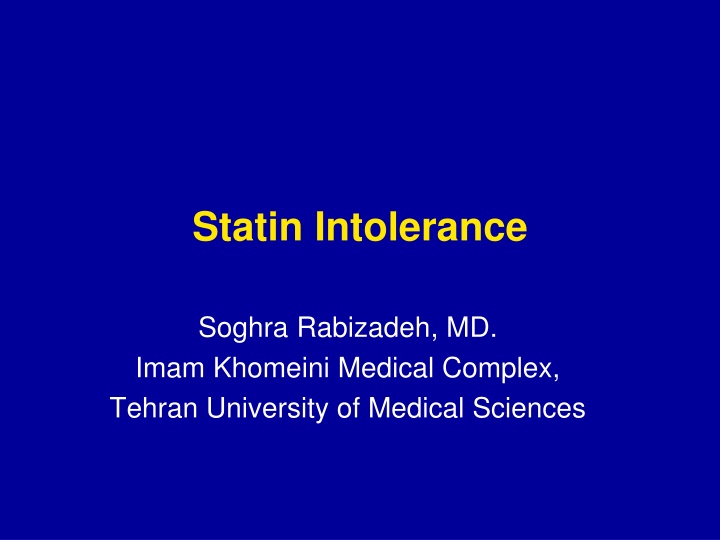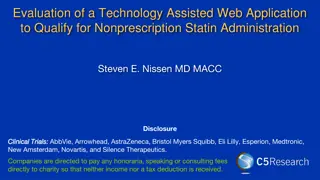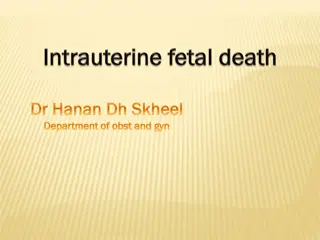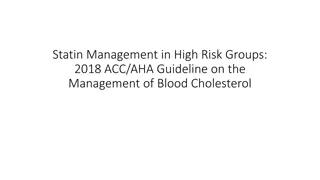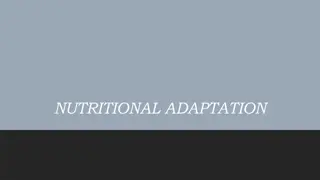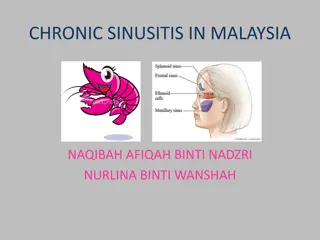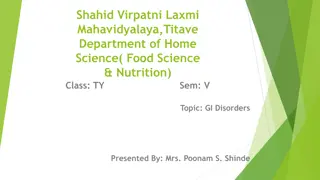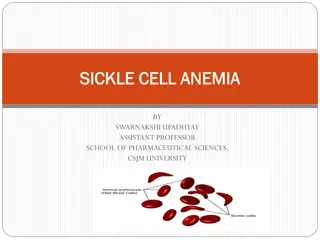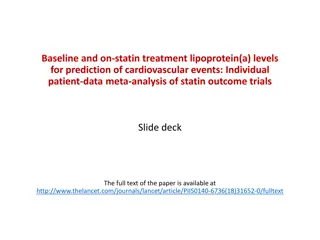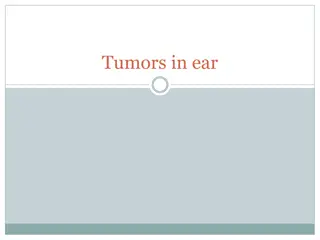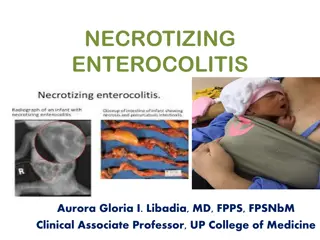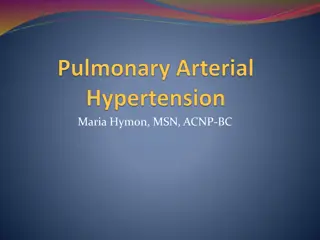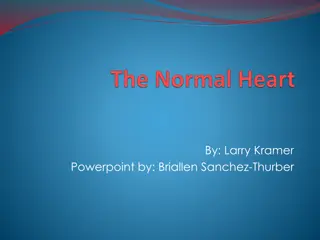Statin Intolerance: Causes, Symptoms, and Management
Statin intolerance is the inability to tolerate at least two statins, with symptoms like muscle aches. Despite the benefits of statins in reducing cardiovascular risk, some patients experience side effects leading to intolerance. Understanding the definition, prevalence, and management of statin intolerance is crucial for optimizing cardiovascular care.
Download Presentation

Please find below an Image/Link to download the presentation.
The content on the website is provided AS IS for your information and personal use only. It may not be sold, licensed, or shared on other websites without obtaining consent from the author.If you encounter any issues during the download, it is possible that the publisher has removed the file from their server.
You are allowed to download the files provided on this website for personal or commercial use, subject to the condition that they are used lawfully. All files are the property of their respective owners.
The content on the website is provided AS IS for your information and personal use only. It may not be sold, licensed, or shared on other websites without obtaining consent from the author.
E N D
Presentation Transcript
Statin Intolerance Soghra Rabizadeh, MD. Imam Khomeini Medical Complex, Tehran University of Medical Sciences
Introduction Statin use has increased progressively in all age groups since 1988 The American Heart Association/ American College of Cardiology guidelines have broadened the indications for their use.
A 21% decrease in CVD mortality and morbidity(stroke and fatal coronary events) can be achieved by lowering LDL-C by 1.0 mmol/l (38.7 mg/dl) Cholesterol Treatment Trialists (CTT) Collaboration, Lancet. 2010;
Statin Use Dyslipidemia Coronary artery disease Acute coronary syndromes Diabetes mellitus Stroke Hypertension CKD
Muscle symptoms Observational data show that about 10% to 20% of patients treated with statins complain of muscle symptoms (usually muscle aches) Analyses of muscle symptoms in double- blind, placebo-controlled randomized trials of statins have shown small numerical increases in muscle symptoms of about 0.3% (which is not statistically significant) Ganga HV,et al. Am Heart J. 2014 Collins R,et al. Lancet. 2016
PRIMO study: Observational study in 7924 patients 30 25 20 Patients % 15 10 18.2 14.9 10.9 5 5.1 0 Pravastatin Atorvastatin Simvastatin Fluvastatin Eric Bruckert, et al. Cardiovascular Drugs and Therapy.2005
PRIMO study: temporal pattern of SAMS Eric Bruckert, et al. Cardiovascular Drugs and Therapy.2005
Definition of statin intolerance International Lipid Expert Panel The Inability to tolerate at least two statins: one statin at the lowest starting daily dose and another statin at any daily dose. Resolution or improvement of symptoms or changes in biomarkers with dose decrease or discontinuation of drug . Symptoms or changes in biomarkers are not attributable to established predisposition factors such as drug drug interactions and recognized conditions increasing the risk of statin intolerance Banach M,et al. Expert Opin Drug Saf. 2015
Statin Myalgia Index Score Clinical symptoms (new or increased unexplained muscle symptoms Regional distribution/pattern Symmetric hip flexors/thigh aches Symmetric calf aches Symmetric upper proximal aches Nonspecific asymmetric, intermittent Temporal pattern Symptoms onset <4 weeks Symptoms onset 4 12 weeks Symptoms onset >12 weeks Dechallenge Improves upon withdrawal (<2 weeks) Improves upon withdrawal (2 4 weeks) Does not improve upon withdrawal (>4 weeks) Challenge Same symptoms reoccur upon rechallenge <4 weeks Same symptoms reoccur upon rechallenge 4 12 weeks Score 3 2 2 1 Probable :9-11 Possible : 7-8 3 2 1 Unlikely: < 7 2 1 0 3 1 Rosenson et al,journal of clinical lipidology.2014
Risk factors for statin associated muscle symptoms Advance age Female Physical disability Lower BMI Hypothyroidism Colchicin , Alcohol (toxic muscle effect) Exercise
Risk factors for statin associated muscle symptoms Medications metabolized by CYP3A4 : Azoles, macrolids,TCA, protease inh, calcium chanel blockers, cyclosporine, tacrolimus, sirolimus, amiodarone, danazole, midazolam, nefazodone, tamoxifen, sildenafil, and warfarin Grapefruit inhibit intestinal CYP3A4 Gemfibrozil interfere with Statin glucoronidation
Approach to symptomatic Statin Related muscle problems
Step1 History and Ph/E to determine potential causes Check CK level & review other labs.( cr,TSH, 25 vitD) CK < 10 ULN NL CK (myalgia) CK> 10 ULN (R/O rhabdomyolysis) (check Cr , urine myoglobin) Saxon DR, Eckel RH. Progress in Cardiovascular Diseases.2016
Step2 Lower statin dose OR discontinue depending severity of symptoms Discontinue statin, intensive management Moderate to severe symptoms, weekly contact If symptoms persists: appropriate referral If symptoms resolve: Rechallenge with statin Severe muscle injury: rechallenge is not appropriate Saxon DR, Eckel RH. Progress in Cardiovascular Diseases.2016
Step2 If statin rechallenge : use different statin or alternative dose Rosuvastatin 5 mg or atorvastatin 10 mg QWK, fluva-1mg or pravastatin 10mg QOD or QD Reassess patients within 6 weeks. Clarify patients LDL goal based on ASCVD risk Saxon DR, Eckel RH. Progress in Cardiovascular Diseases.2016
Step3 Tolerate statin ,reaching LDL goal: Continue drug & follow up Not tolerate low dose statin Tolerate statin, not reaching LDL goal Non statin agents Ezetimibe, bile acid sequestrants, PCSK9 inhibitors, niacin and fibrate Saxon DR, Eckel RH. Progress in Cardiovascular Diseases.2016
The interaction between statins and exercise The combined use of statins and exercise training (ET) can result in health gains and decreased CVD risk Some of the events: decreased athletic performance, muscle injury, myalgia, joint problems, decreased muscle strength, and fatigue
Strategies to Decrease the Risk of Adverse Interactions Between Statin and Exercise Training (ET) Reassess the need for statin. Decrease the dose of statin. Change to a hydrophilic statin.(pravastatin , rosuvastatin) Prescribe a statin holiday followed by a rechallenge. Decrease the intensity of ET. Decrease the duration of ET. Prescribe vitamin D replacement. Prescribe coenzyme Q10 supplementation. Prescribe L-carnitine supplementation. Avoid drug interactions that increase toxicity Richard E. Deichmann, et al. The Ochsner Journal.2015
Case1 A 54 y/o man with history of elevated cholestrol and PCI at age 52 His complaint is pain in thighs DH: Atorvastatin 80 mg witch was decreased to 40 mg due to calf pain and discontinue it and now on ezetimibe10 /simvastatin40 FH: IHD in his father in 65 y His examination was normal, no muscle weakness or tenderness. BP:135/70, HR:86 , BMI: 26 kg/m
case1 Question: What laboratory tests would you recommend?
Case 1 : Lab tests CK: 175 U/l, chol: 175 mg/dl, LDL:112 mg/dl, HDL:45, TG:160, A1c:6 %, TSH:1, vit D: 36 ng/ml What is the next step ?
Case1 A) Rechallenge with rosuvastatin immediately B) discontinue ezetimibe/simvastatin for2 weeks C) discontinue ezetimibe/simvastatin and prescribe PCSK9 D) Reassure the patient that symptoms are not related to statin
Statin use is critical in this patient because high cardiovascular risk First step would be to reassure the patient that his muscle symptoms are rarely caused by the statin and statins are essential for people with coronary artery disease to reduce the incidence of heart attack and death.
A cornerstone in treating patients with SAMS is communication. careful history taking , counseling regarding diet and other modifible risk factors, clear counseling about the benefit and low incidence of side effects with statins
Statin and liver Reversible , dose dependent and asymptomatic elevation of liver enzymes Persistent elevation in ALT or AST> 3 ULN in about 3% of patients receiving high dose statins Liver enzymes elevation alone without increases in bilirubin don t indicate severe hepatic injury FDA .2012
2014 NLA Statin Safety Task Force Questions
Question1 Have any unexpected safety concerns arisen since the regulatory recommendation that liver enzymes need not be measured after initiating statin therapy? NO Irreversible liver damage with statins is exceptionally rare and is idiosyncratic.
Question 2 Should baseline liver enzymes be obtained before initiating statin therapy? Yes Liver enzymes tests should be performed before starting statin and as clinically indicated thereafter
Question 3 Are statins safe to use in patients with nonalcoholic fatty liver disease? Yes chronic liver diseases and compensated cirrhosis were not contraindications for statin use.
Question 4 Can statins safely be used in liver transplant recipients? Yes Cardiovascular events are common among liver transplant patients
Question 5 Can statins safe in patients with autoimmune hepatitis? Yes
Causes of elevated liver enzymes Celiac disease Congestive cardiomyopathy Endocrine disease : DM, metabolic syn Ethanol intake Fatty liver Gallbladder disease Genetic diseases: Alpha 1 antitrypsin deficiency,CF, Hemochromatosis , Wilson s disease Infections Malignancies Autoimmune HELP syn Medications
Patients wit elevated liver enzymes ALT or AST < 3 ULN History & Ph/E for other causes Review prior liver enzymes tests Repeat tests to confirm elevation Total bilirubin elevated CK normal Total bilirubin normal CK normal
Total bilirubin normal CK normal Total bilirubin elevated CK normal If the most diagnosis is NAFLD Prior bilirubin (Gilbert) OK to start statin Lifestyle change Asymptomatic Prior bili is periodically elevated Indirect bili elevated Continue statin Repeat liver tests
Prior bili NL Now bili (specially direct) liver biopsy or imaging if liver enzymes don t improve with discontinuing statin and lifestyle change
Patient with ALT or AST > 3 ULN History & PH/E Review prior liver enzyme tests Repeat tests immediately ALT or AST >3 ULN CK NL
ALT or AST >3 ULN CK NL Stop statin Stop other drugs that may have liver toxicity If patient is overweight or obese , lifestyle modification Check Albumin, PT, CBC Diagnostic tests : Alkp, viral hepatiis,FBS, Hb A1c,TFT,ANA,ASMA ,AMA, anti liver- kidney microsomal ab, Anti TTG, ferritin ,TS, Ceruloplasmin, ? ?? ?? ?? ?? ?? ?? ?? ?? ?? ?? ?? ?? ?, ? ?? ?? ?? ?? ?? ?? ?? ?? ?? ?? ?? ?? ?? ?? ?? ?? ?? ?? ?? ? liver biopsy or imaging if liver enzymes don t improve with discontinuing statin and lifestyle change
Case A 65 y/o man with history of CAD, taking rosuvastatin 20 mg daily ALT and AST about 2 times ULN BMI : 33, LDL: 84 mg/dl, TG: 220 mg/dl Bilirubin, Alkp, PT& platelet NL No symptoms No alcohol
How would you manage ? A. Repeat transaminase tests and if still elevated above ULN, discontinue rosuvastatin B. Continue rosuvastatin and repeat transaminase tests and life style modification C. Use another statin, and repeat transaminases tests D. Discontinue statin and refer the patient to a hepatologist
Thanks for your attention
